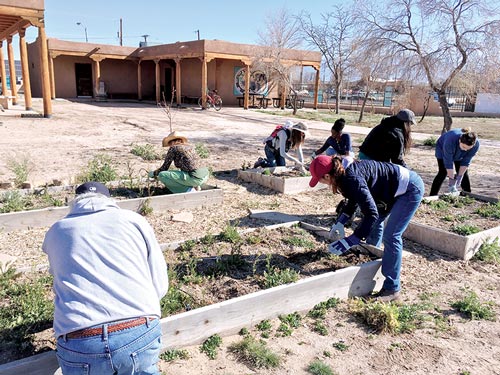
Garden at the IPCC yields more than fruits, vegetables

Submitted | IPCC At the first Seasons of Growth Learning class held on March 12, several Albuquerque residents learn basics about composting and amending the soil while helping to develop the Resilience Garden.

Submitted | IPCC
At the first Seasons of Growth Learning class held on March 12, several Albuquerque residents learn basics about composting and amending the soil while helping to develop the Resilience Garden.
ALBUQUERQUE
The Resilience Garden on the grounds of the Indian Pueblo Cultural Center is no ordinary garden. It’s a journey that takes you thousands of years back into the past.
Then, leaves you off in the present with knowledge of traditional Pueblo farming, water systems and conservation techniques that survived despite colonizing efforts to wipe them out.
“We have a clear story to tell,” said Bettina Sandoval, Taos Pueblo, Cultural Education Specialist at the center.
In four elongated plots, the Resilience Garden demonstrates how Pueblo people preserved their way of life.
“Throughout everything, the Pueblos have maintained their language, their culture, their farming,” noted Sandoval who designed and built the garden with staff and volunteers.
Stepping back into time, the first plot reflects the practice of foraging for fruits and vegetables before the Spanish invaded Pueblo lands and the U.S. set its sights on a Manifest Destiny.
“The idea of the first area is to show the abundance of foods tribes had even before they started farming and gardening,” said Sandoval, adding that in the mountainous terrain near her homelands, plums, chokecherries, and many other fruits and vegetables grow wild.
“We still go and gather. We know where to get them,” she remarked.
Walking along the path that weaves in and around the garden rows, Sandoval moved the story of Pueblo farming ahead in time. Pointing to the second row, waffle-looking designs emerge from indented mounds lined up next to each other.
The waffling method was used early on by Zuni farmers, who have worked the high desert, southwestern lands for more than a thousand years, according to historical records.
“If there wasn’t any rain in a week, instead of flooding an entire field, the Zuni people realized it was better to concentrate the water. The raised edges keeps water around the plants instead of needlessly overflowing a plot of land,” explained Sandoval.
To read the full article, pick up your copy of the Navajo Times at your nearest newsstand Thursday mornings!
Are you a digital subscriber? Read the most recent three weeks of stories by logging in to your online account.








 Highway 264,
Highway 264, I-40, WB @ Winslow
I-40, WB @ Winslow